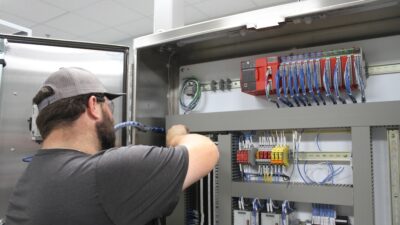The other day while visiting a plant, I sat in on an interesting discussion related to the future of programmable logic controllers (PLCs). The PLCs at this plant were aging and needed to be replaced and the conversation focused on what hardware would replace them. There were really three choices: new PLCs, hardened PCs, or programmable automation controllers (PACs).
The other day while visiting a plant, I sat in on an interesting discussion related to the future of programmable logic controllers (PLCs). The PLCs at this plant were aging and needed to be replaced and the conversation focused on what hardware would replace them. There were really three choices: new PLCs, hardened PCs, or programmable automation controllers (PACs).
The argument for the PLCs was quite good. Basically, replacing the old PLCs with new ones permits the code (written in ladder logic) to be easily ported. The plant personnel are quite familiar with the PLCs and the ladder logic. Also, the PLC is a robust and well proven technology.
The big problem with the PLC is that it is fairly expensive, and ladder logic can get complicated and messy when trying to do advanced programming. In fact, ladder logic is not a particularly popular topic in the classroom. In general, ladder logic is difficult to teach and difficult to learn. Many newer graphically oriented products are now available that are much more user friendly and intuitive, making them preferred buy instructors and students alike. Fortunately, many of these are compilers that generate ladder logic from user input, which allows them to be used with PLC hardware.
The hardened PC provides capabilities such as flexibility, intuitive programming, ease of integrating hardware, and networking capabilities. On the negative side, you have to buy a pricey hardened PC for plant operations. Also, PCs do have a tendency to crash, and there are no guarantees related to real-time operations. (PCs can be fairly fragile, especially the hard drive, but new solid state hard drives are eliminating that issue.) Furthermore, PCs typically do not run ladder logic, so technicians and engineers have to be retrained to program in a different environment.
The third option, the PAC, is capable of running ladder logic, but may be programmed in a variety of different formats such as C, Java and LABView. As you can imagine, these programming capabilities could take PLC-type operations to the next level in many areas, such as communication, data crunching, and user interface development.
PACs comes in two major flavors. The first is a hardware implementation, where a PLC is augmented with extra hardware to provide added flexibility and capabilities. The second is a software approach, where a PC is programmed using a real-time operating system to achieve PLC-type functionality. In either case, the result is a real-time system that is capable of mimicking a PLC, but has the added flexibility of a PC.
So, will the PAC replace the PLC and the factory hardened computer? I like to think about the PAC taking the same path that the PC has in our homes and offices. Like the PC, the PAC has the potential to replace a number of systems. The PC, for example, has replaced specialized word processing hardware with a few exceptions. (I still do see typewriters around, but they typically cost more than a PC.) The PC also could replace CD players, DVD players and telephones.
The same can be said for the PACs. They will grab some of the PLC market share, but not all of it. Certainly, the high-end PLC operations will migrate towards PACs, as they provide significantly more capabilities at a very competitive price. For simpler tasks that have used PLCs for several decades, however, the price and capabilities of PACs may not justify their use. Hardened PCs will still have their place in automation, but classic PLCs will probably go the way of the typewriter. PLCs will be around and have their uses, but fewer and fewer people will really want to use them. They will ultimately be more expensive than PACs with comparable capabilities, the new graphical programming packages for PLCs will enable porting of applications to other platforms. This will make the programming of PLCs somewhat platform-independent, enabling PLC manufacturers to cost-effectively migrate to alternative hardware configurations without dramatic shifts in user compatibility.
Author Information
Thomas R. Kurfess, Ph.D., P.E., is BMW Chair of Manufacturing at



